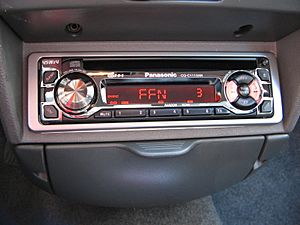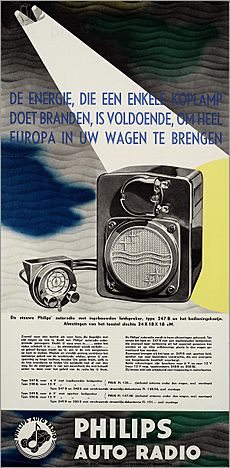Vehicle audio facts for kids
Vehicle audio is all the sound equipment in a car or other vehicle. It provides fun and information for people inside the car. For a long time, it was just a simple radio. But over the years, many cool things were added. These include FM radio, tape players, CD players, and even DVD or Blu-ray players. Newer cars have navigation systems, Bluetooth for phones, and ways to connect your smartphone like CarPlay and Android Auto. What used to be controlled by a few buttons on the dashboard can now be controlled from the steering wheel or even with your voice!
At first, car audio was mainly for listening to music and radio. Now, it's part of a car's smart systems. It helps with communication, safety, hands-free calling, navigation, and even checking the car's health from far away. The same speakers can also make the car quieter by reducing road and engine noise. Or, they can make a small engine sound bigger and more powerful!
Contents
History of Car Audio
Early Radios in Cars
Back in 1904, an American inventor named Lee de Forest showed off a car radio. This was even before mobile radio technology was ready for everyone to use.
Around 1920, radio technology got better. This meant that radio broadcasts became possible. A big challenge was that early radios needed a lot of power (50 to 250 volts). But car batteries only gave 6 volts. So, inventors had to find ways to boost the power.
In 1924, the first car radio was installed in Australia. By 1930, a company called Galvin Manufacturing sold a Motorola car radio for $130. This was very expensive! A Ford Model A car cost about $540 back then. In Germany, a Blaupunkt radio in 1932 cost about one-third the price of a small car. These early radios were also quite large. They often had to be placed away from the driver and controlled by a remote. By the late 1930s, AM radios with push buttons became a common feature in cars. By 1946, about 9 million AM car radios were in use.
FM radio came to cars in 1952 with Blaupunkt. In 1953, Becker introduced a radio that could scan for stations.
In 1955, Chrysler offered a car radio that used only transistors. Transistors were a new technology that made electronics smaller and more reliable than older vacuum tubes. This radio was too expensive, so Chrysler later switched to a mix of transistors and tubes. By 1963, Becker made a radio with no vacuum tubes at all.
From 1974 to 2005, a system called ARI was used in Germany. It helped drivers know about traffic announcements. It was later replaced by the Radio Data System (RDS).
Even today, the AM/FM radio combined with a CD player is still common in cars. This is true even though CDs are not as popular for music outside of cars anymore.
In the 2010s, internet radio and satellite radio started to compete with FM radio. Some car audio systems even offered surround sound, like in a movie theater!
Recently, some car makers like Ford, Audi, BMW, Volvo, and Tesla thought about removing AM radio from new cars. This was especially true for electric cars. However, Ford changed its mind because AM radio is important for emergency alerts. Lawmakers also wanted to make sure AM radio stayed in cars.
Playing Music from Tapes and Discs
Cars have had players for many types of music media over the years. These include vinyl records, 8-track tapes, cassette tapes, and compact discs (CDs). Because car audio systems became so valuable, they also became targets for thieves. So, anti-theft systems were added to them.
The first try at playing music from records in cars was in the 1950s. Chrysler offered a record player in 1956. It played special 7-inch records. This was an expensive option and didn't last long. Other companies also tried record players, but they often caused records to wear out quickly because the needle had to press harder to avoid skipping.
In 1962, the 4-track tape player came out. Famous people like Frank Sinatra had them in their cars.
In 1965, Ford and Motorola introduced the 8-track tape player as an option in Ford cars. Then, in 1968, Philips brought out a car radio with a built-in cassette tape player. Cassettes soon became more popular than 8-tracks. They could play longer, sounded better, and had features like auto-reverse and noise reduction. Cassette players were very popular in the 1970s and 1980s. Some cars even had them as late as 2008! Some car stereos could play both cassettes and CDs.
Pioneer introduced the first car CD player in 1984. CDs offered much better sound quality and you could skip tracks instantly. They were also more durable than cassette tapes. Car CD changers, which could hold many CDs, became popular in the late 1980s and 1990s. Some were in the trunk, and later ones were built into the dashboard. The first car with a factory-installed CD player was the 1987 Lincoln Town Car. The last new cars in America to have a cassette player in the dashboard were the 2010 Lexus SC430 and Ford Crown Victoria. People could also use a cassette adapter to play music from portable CD or MP3 players through their car's cassette deck.
In the early 2000s, digital music storage became popular. Car audio systems started to include ways to connect Bluetooth devices, USB drives, and memory cards. Auxiliary input jacks and USB ports were added so you could plug in your MP3 player. Minivans and large SUVs often have rear entertainment systems with DVD players to keep passengers busy.
Today, the car's main audio unit (called the head unit) is very important. It can show video from front and backup cameras, help with navigation, and run systems like Android Auto and CarPlay. These systems let you control your smartphone's music and navigation apps right from the car's screen. Newer models have Bluetooth and HDMI ports for even better connections. Screens can range from 5 to 7 inches in size.
Making Cars Quieter or Louder
Your car's sound system can also be part of a special system that makes the car quieter. This is called active noise control. It reduces engine and road noise for everyone inside the car. Microphones pick up sounds from different parts of the car, like the engine or exhaust pipes. A computer then processes these sounds and sends new sounds through the car speakers. These new sounds cancel out the unwanted noise, making the car much quieter.
An early system for engine noise was developed by Lotus in 1992 for Nissan cars. Later, Lotus and Harman worked together to create a system that reduced road and tire noise too. A great thing about active noise control is that cars can be lighter. They need less heavy sound-deadening material. It can also help save fuel! Many modern cars, like the Honda Accord and Lincoln luxury cars, use active noise control. These systems can remove up to 80% of unwanted noise.
The same system can also be used to make engine sounds louder or more powerful for the driver. For example, some Ford Mustang and F-150 models use an "Active Noise Control" system to make the engine sound stronger through the car speakers. Volkswagen uses a special speaker called a "Soundaktor" to play sounds in cars like the Golf GTi. BMW even plays recorded sounds of its engines through the car speakers, changing the sound based on how the engine is working.
Car Audio Parts
When you buy a car, it comes with a stock system. This is the audio equipment the car maker chose to put in. You can also buy aftermarket components to upgrade your car's sound.
- Head unit: This is the main part of the car stereo, usually in the dashboard. It has the screen, buttons, and controls. They come in standard sizes called single DIN or double DIN.
- Connectors: These are the cables and plugs that connect all the audio parts.
- Capacitors: These help store and release electrical energy to keep the sound steady.
- Amplifiers: These make the audio signals stronger. Some head units have small amplifiers built-in. Other car audio systems use a separate, more powerful amplifier. Amplifiers have a power rating that tells you how strong they are.
Here are some types of speakers you might find in a car:
- Coaxial speakers: These are the most common type. They have a woofer (for low sounds) and a tweeter (for high sounds) built together. They play a wide range of sounds.
- Component speakers: These are for better sound quality. They have separate woofers, tweeters, and special parts called crossovers. This allows for more exact sound tuning.
- Subwoofers: These speakers are designed to play very low sounds, especially bass. They come in different sizes and power levels and make the bass in your car sound much deeper.
- Mid-range speakers: These speakers play sounds in the middle range, like voices and instruments such as guitars or pianos.
- Tweeters: These speakers play very high-pitched sounds, like cymbals.
- Sound-deadening material: This is often put inside car doors and the trunk. It stops the car panels from vibrating too much when loud bass sounds are playing.
- Optical drives: These are the CD or DVD players in your car, often with a slot where you slide the disc in.
Car Audio Rules
Having very loud sound systems in cars can break noise rules in many towns and cities. Some places have even made laws against them. In 2002, the U.S. Department of Justice gave police officers advice on how to handle problems with loud car audio systems.
Gallery
-
1978 AMC Matador sedan factory AM-FM-stereo-8-track unit with an album by The Blues Brothers
See also
 In Spanish: Audio para automóvil para niños
In Spanish: Audio para automóvil para niños
- List of car audio manufacturers and brands
- Active sound design















